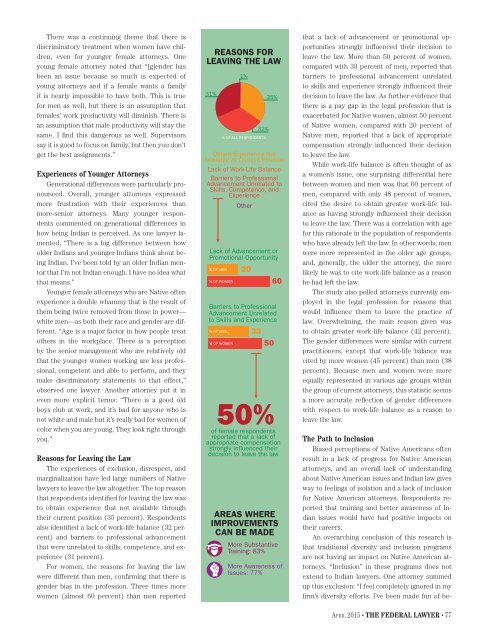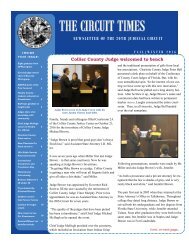For-Native-American-Attorneys-Groundbreaking-NNABA-Study-Reveals-Devastating-Lack-of-Inclusion-in-t.aspx?FT=
For-Native-American-Attorneys-Groundbreaking-NNABA-Study-Reveals-Devastating-Lack-of-Inclusion-in-t.aspx?FT=
For-Native-American-Attorneys-Groundbreaking-NNABA-Study-Reveals-Devastating-Lack-of-Inclusion-in-t.aspx?FT=
You also want an ePaper? Increase the reach of your titles
YUMPU automatically turns print PDFs into web optimized ePapers that Google loves.
There was a cont<strong>in</strong>u<strong>in</strong>g theme that there is<br />
discrim<strong>in</strong>atory treatment when women have children,<br />
even for younger female attorneys. One<br />
young female attorney noted that “[g]ender has<br />
been an issue because so much is expected <strong>of</strong><br />
young attorneys and if a female wants a family<br />
it is nearly impossible to have both. This is true<br />
for men as well, but there is an assumption that<br />
females' work productivity will dim<strong>in</strong>ish. There is<br />
an assumption that male productivity will stay the<br />
same. I f<strong>in</strong>d this dangerous as well. Supervisors<br />
say it is good to focus on family, but then you don't<br />
get the best assignments.”<br />
Experiences <strong>of</strong> Younger <strong>Attorneys</strong><br />
Generational differences were particularly pronounced.<br />
Overall, younger attorneys expressed<br />
more frustration with their experiences than<br />
more-senior attorneys. Many younger respondents<br />
commented on generational differences <strong>in</strong><br />
how be<strong>in</strong>g Indian is perceived. As one lawyer lamented,<br />
“There is a big difference between how<br />
older Indians and younger Indians th<strong>in</strong>k about be<strong>in</strong>g<br />
Indian. I’ve been told by an older Indian mentor<br />
that I’m not Indian enough. I have no idea what<br />
that means.”<br />
Younger female attorneys who are <strong>Native</strong> <strong>of</strong>ten<br />
experience a double whammy that is the result <strong>of</strong><br />
them be<strong>in</strong>g twice removed from those <strong>in</strong> power—<br />
white men—as both their race and gender are different.<br />
“Age is a major factor <strong>in</strong> how people treat<br />
others <strong>in</strong> the workplace. There is a perception<br />
by the senior management who are relatively old<br />
that the younger women work<strong>in</strong>g are less pr<strong>of</strong>essional,<br />
competent and able to perform, and they<br />
make discrim<strong>in</strong>atory statements to that effect,”<br />
observed one lawyer. Another attorney put it <strong>in</strong><br />
even more explicit terms: “There is a good old<br />
boys club at work, and it’s bad for anyone who is<br />
not white and male but it’s really bad for women <strong>of</strong><br />
color when you are young. They look right through<br />
you.”<br />
Reasons for Leav<strong>in</strong>g the Law<br />
The experiences <strong>of</strong> exclusion, disrespect, and<br />
marg<strong>in</strong>alization have led large numbers <strong>of</strong> <strong>Native</strong><br />
lawyers to leave the law altogether. The top reason<br />
that respondents identified for leav<strong>in</strong>g the law was<br />
to obta<strong>in</strong> experience that not available through<br />
their current position (35 percent). Respondents<br />
also identified a lack <strong>of</strong> work-life balance (32 percent)<br />
and barriers to pr<strong>of</strong>essional advancement<br />
that were unrelated to skills, competence, and experience<br />
(31 percent).<br />
<strong>For</strong> women, the reasons for leav<strong>in</strong>g the law<br />
were different than men, confirm<strong>in</strong>g that there is<br />
gender bias <strong>in</strong> the pr<strong>of</strong>ession. Three times more<br />
women (almost 60 percent) than men reported<br />
REASONS FOR<br />
LEAVING THE LAW<br />
31%<br />
1%<br />
32%<br />
% OF ALL RESPONDENTS<br />
35%<br />
Obta<strong>in</strong> Experience Not<br />
Available At Current Position<br />
<strong>Lack</strong> <strong>of</strong> Work-Life Balance<br />
Barriers to Pr<strong>of</strong>essional<br />
Advancement Unrelated to<br />
Skills, Competence, and<br />
Experience<br />
Other<br />
<strong>Lack</strong> <strong>of</strong> Advancement or<br />
Promotional Opportunity<br />
% OF MEN 20<br />
% OF WOMEN 60<br />
Barriers to Pr<strong>of</strong>essional<br />
Advancement Unrelated<br />
to Skills and Experience<br />
% OF MEN 33<br />
% OF WOMEN 50<br />
50%<br />
<strong>of</strong> female respondents<br />
reported that a lack <strong>of</strong><br />
appropriate compensation<br />
strongly <strong>in</strong>fluenced their<br />
decision to leave the law<br />
AREAS WHERE<br />
IMPROVEMENTS<br />
CAN BE MADE<br />
More Substantive<br />
Tra<strong>in</strong><strong>in</strong>g: 83%<br />
More Awareness <strong>of</strong><br />
Issues: 77%<br />
that a lack <strong>of</strong> advancement or promotional opportunities<br />
strongly <strong>in</strong>fluenced their decision to<br />
leave the law. More than 50 percent <strong>of</strong> women,<br />
compared with 33 percent <strong>of</strong> men, reported that<br />
barriers to pr<strong>of</strong>essional advancement unrelated<br />
to skills and experience strongly <strong>in</strong>fluenced their<br />
decision to leave the law. As further evidence that<br />
there is a pay gap <strong>in</strong> the legal pr<strong>of</strong>ession that is<br />
exacerbated for <strong>Native</strong> women, almost 50 percent<br />
<strong>of</strong> <strong>Native</strong> women, compared with 20 percent <strong>of</strong><br />
<strong>Native</strong> men, reported that a lack <strong>of</strong> appropriate<br />
compensation strongly <strong>in</strong>fluenced their decision<br />
to leave the law.<br />
While work-life balance is <strong>of</strong>ten thought <strong>of</strong> as<br />
a women’s issue, one surpris<strong>in</strong>g differential here<br />
between women and men was that 60 percent <strong>of</strong><br />
men, compared with only 48 percent <strong>of</strong> women,<br />
cited the desire to obta<strong>in</strong> greater work-life balance<br />
as hav<strong>in</strong>g strongly <strong>in</strong>fluenced their decision<br />
to leave the law. There was a correlation with age<br />
for this rationale <strong>in</strong> the population <strong>of</strong> respondents<br />
who have already left the law. In other words, men<br />
were more represented <strong>in</strong> the older age groups,<br />
and, generally, the older the attorney, the more<br />
likely he was to cite work-life balance as a reason<br />
he had left the law.<br />
The study also polled attorneys currently employed<br />
<strong>in</strong> the legal pr<strong>of</strong>ession for reasons that<br />
would <strong>in</strong>fluence them to leave the practice <strong>of</strong><br />
law. Overwhelm<strong>in</strong>g, the ma<strong>in</strong> reason given was<br />
to obta<strong>in</strong> greater work-life balance (42 percent).<br />
The gender differences were similar with current<br />
practitioners, except that work-life balance was<br />
cited by more women (45 percent) than men (38<br />
percent). Because men and women were more<br />
equally represented <strong>in</strong> various age groups with<strong>in</strong><br />
the group <strong>of</strong> current attorneys, this statistic seems<br />
a more accurate reflection <strong>of</strong> gender differences<br />
with respect to work-life balance as a reason to<br />
leave the law.<br />
The Path to <strong>Inclusion</strong><br />
Biased perceptions <strong>of</strong> <strong>Native</strong> <strong>American</strong>s <strong>of</strong>ten<br />
result <strong>in</strong> a lack <strong>of</strong> progress for <strong>Native</strong> <strong>American</strong><br />
attorneys, and an overall lack <strong>of</strong> understand<strong>in</strong>g<br />
about <strong>Native</strong> <strong>American</strong> issues and Indian law gives<br />
way to feel<strong>in</strong>gs <strong>of</strong> isolation and a lack <strong>of</strong> <strong>in</strong>clusion<br />
for <strong>Native</strong> <strong>American</strong> attorneys. Respondents reported<br />
that tra<strong>in</strong><strong>in</strong>g and better awareness <strong>of</strong> Indian<br />
issues would have had positive impacts on<br />
their careers.<br />
An overarch<strong>in</strong>g conclusion <strong>of</strong> this research is<br />
that traditional diversity and <strong>in</strong>clusion programs<br />
are not hav<strong>in</strong>g an impact on <strong>Native</strong> <strong>American</strong> attorneys.<br />
“<strong>Inclusion</strong>” <strong>in</strong> these programs does not<br />
extend to Indian lawyers. One attorney summed<br />
up this exclusion: “I feel completely ignored <strong>in</strong> my<br />
firm’s diversity efforts. I’ve been made fun <strong>of</strong> be-<br />
April 2015 • THE FEDERAL LAWYER • 77



